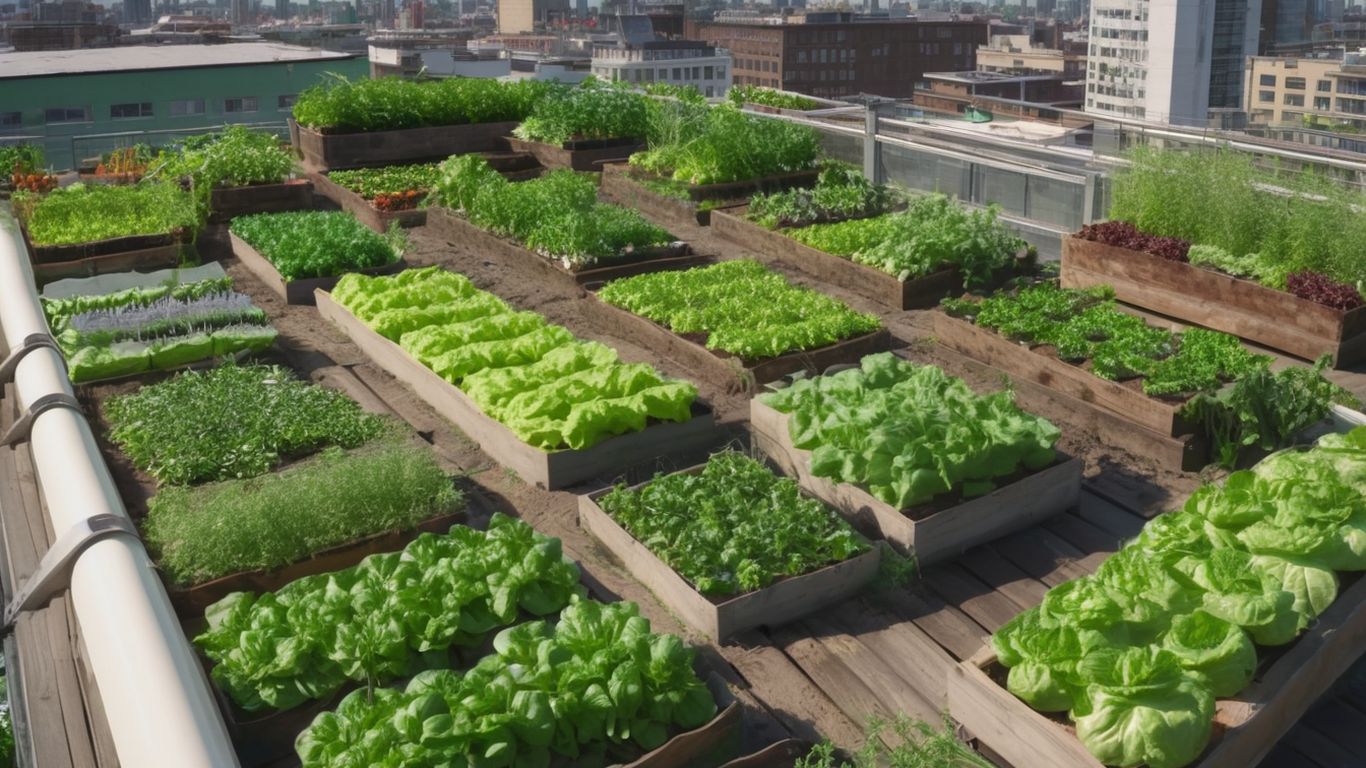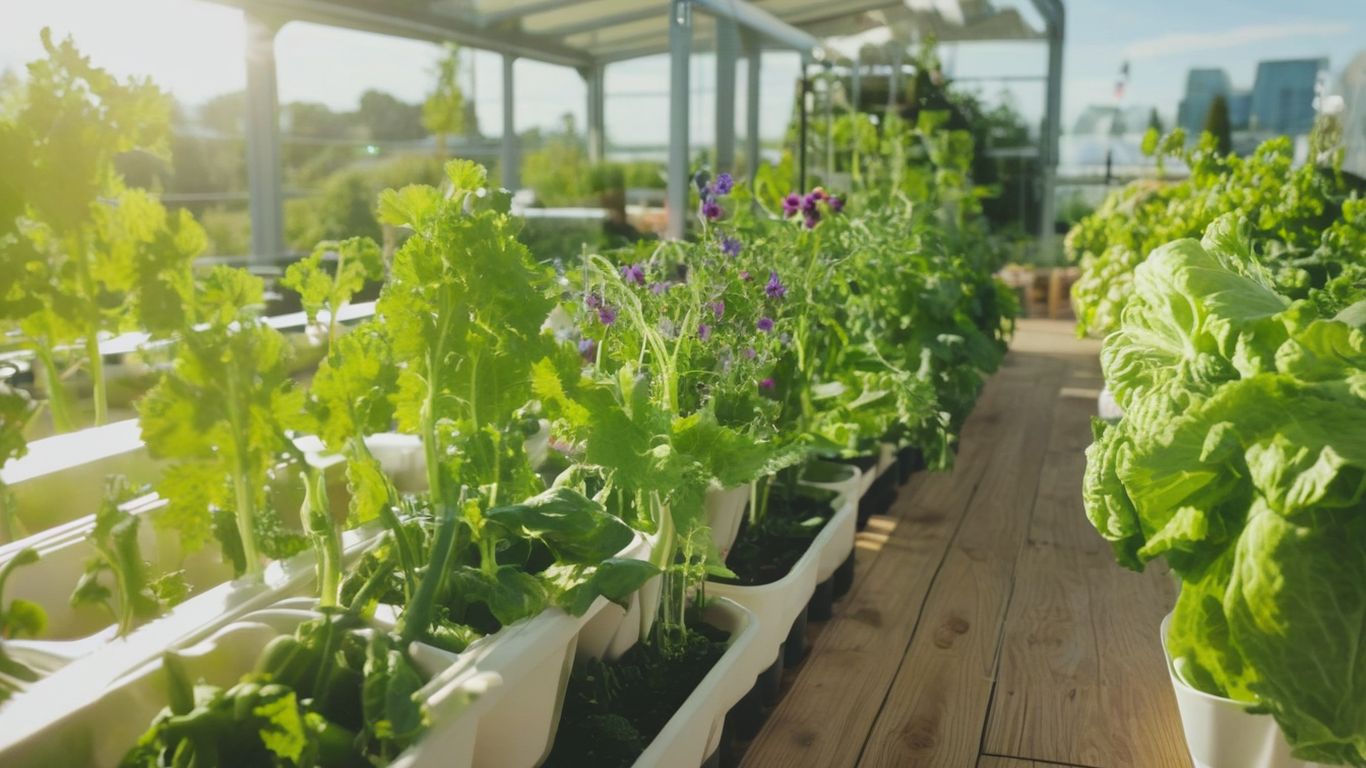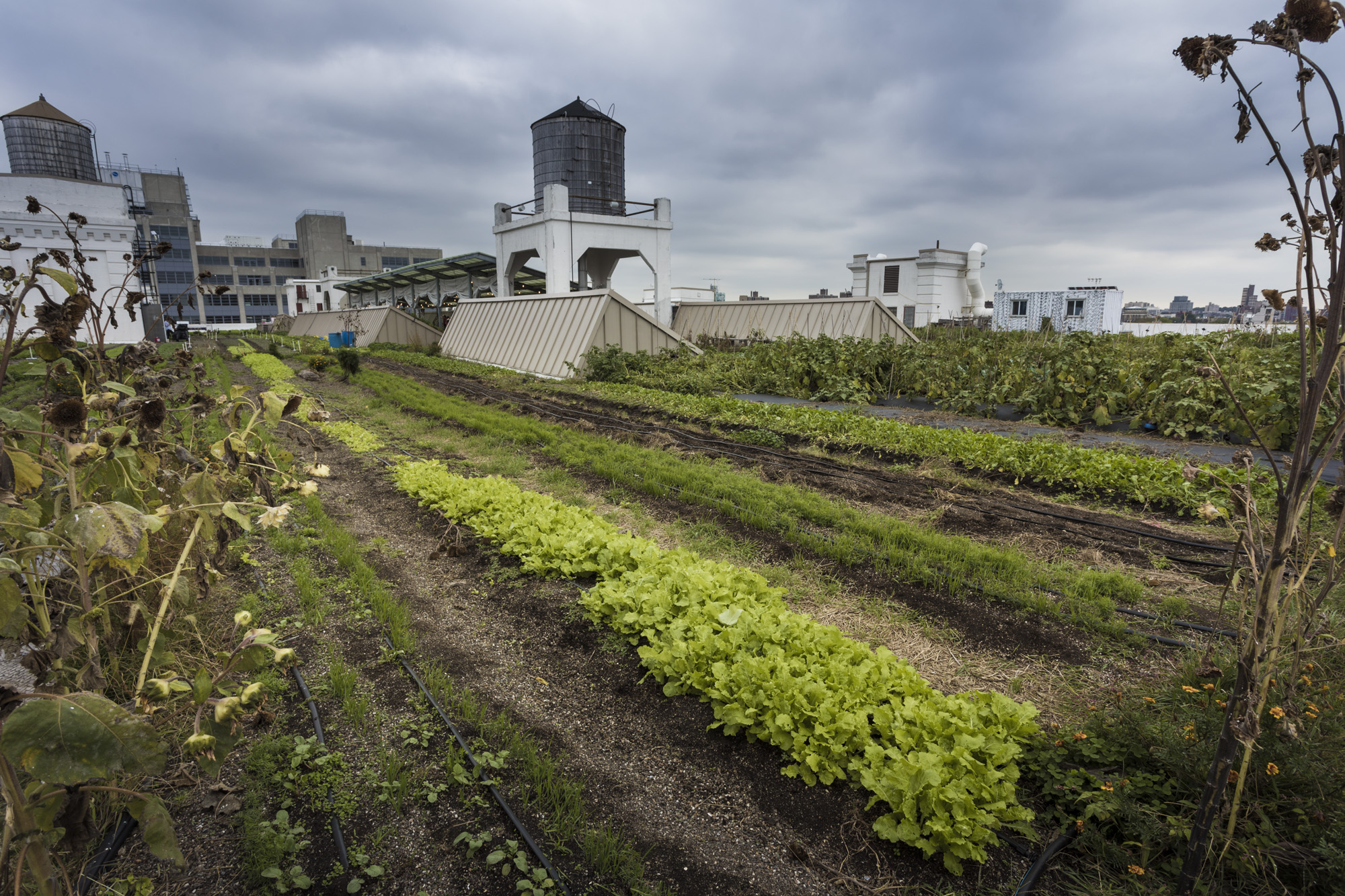Article-at-a-Glance
- Container gardening allows for high yields in small urban spaces.
- Hydroponic systems enable soil-less farming, perfect for rooftop environments.
- Vertical farming takes advantage of height to grow more in less space.
- Aquaponics combines fish farming with plant cultivation for a sustainable ecosystem.
- Green roofs provide environmental benefits and can also be aesthetically pleasing.
Growing Upwards: Urban Rooftop Farming Solutions
Urban rooftops are more than just idle spaces, they can be transformed into vibrant, green oases that feed our cities. With space at a premium and concrete jungles expanding, it’s time to look upwards for solutions. Let’s explore the innovative farming techniques that are changing the landscape of urban agriculture and how you can start your own rooftop farm.
Container Gardening: Small Spaces, Big Yields
When space is limited, creativity is key. Container gardening is a versatile solution that makes the most of every square inch of your rooftop. Here’s how to get started:
- Choose containers that fit your space and can accommodate the root size of your chosen plants.
- Opt for high-quality potting mix that provides good drainage and nutrient content.
- Select plants that thrive in containers, like herbs, leafy greens, and compact vegetables.
Most importantly, ensure your roof can support the weight of your garden. Consult a structural engineer if you’re unsure, because safety always comes first.

Hydroponics: Soil-less Farming on the Roof
Hydroponics is a game-changer for urban farmers. This method uses nutrient-rich water to grow plants without soil. It’s clean, efficient, and yields produce faster than traditional methods. Here’s a simple guide to start your hydroponic rooftop farm:
- Set up a hydroponic system that suits your space—there are many DIY kits available.
- Choose leafy greens and herbs as they are among the easiest and most rewarding plants to grow hydroponically.
- Monitor the pH and nutrient levels regularly to keep your plants happy and healthy.
Because you’re controlling the environment, your plants are less likely to face pests and diseases. That means less work for you and more delicious greens on your plate.
Vertical Farming: Maximizing Height for More Greens
Vertical farming is about growing up, not out. This approach uses tiered gardening structures to grow more food in less space. Here’s how to make the vertical leap:
- Design a structure that can securely hold pots or shelves for your plants.
- Choose vine plants like tomatoes and cucumbers, or leafy greens that don’t need deep soil.
- Ensure each plant gets enough light—either by placing them strategically or using grow lights.
This method is not only efficient but also turns your rooftop into a lush, green sanctuary.
Aquaponics: Fish and Plants in Symbiotic Harmony
Aquaponics may sound complex, but it’s a beautifully simple ecosystem. Fish produce waste that acts as a natural fertilizer for the plants, and the plants clean the water for the fish. To get started:
- Set up a fish tank and connect it to a plant bed where the water can circulate.
- Choose fish that thrive in your climate and plants that benefit from nutrient-rich water.
- Maintain a balanced ecosystem by regularly checking water quality and fish health.
It’s a win-win: you get fresh produce and fish, all from the same system!
Digging into Hydroponics
Now, let’s dive deeper into hydroponics. This soil-free farming technique is perfect for rooftops because it eliminates the need for heavy, space-consuming soil and allows for a clean and controlled growing environment.
Building Your Own Hydroponic System
Building a hydroponic system might seem daunting, but with a little guidance, you’ll be up and running in no time. Start with a simple system like deep water culture (DWC) or nutrient film technique (NFT). You’ll need a reservoir for the nutrient solution, a pump to circulate water, and containers or channels for your plants. Remember to use materials that are food-safe and durable enough to withstand constant moisture.
The Best Plants for Hydroponic Rooftops
Not all plants are suited for hydroponic systems, but many thrive in them. Lettuce, spinach, and herbs like basil and mint are great starters because they grow quickly and don’t need much support. For a bigger challenge, try tomatoes or strawberries. These need more care but are incredibly rewarding when you harvest your own juicy fruits from the roof.
Green Roofs: More Than Just a Pretty Space
Green roofs are not just about growing food, they’re about creating a sustainable ecosystem on your rooftop. They provide insulation, reduce stormwater runoff, and improve air quality. Plus, they can be incredibly beautiful, transforming your building into a living piece of art.
The Basics of Installing a Green Roof
Installing a green roof involves more than just planting. You need a waterproof membrane to protect your building, a drainage layer, a growing medium, and the right plants—typically drought-resistant species like sedums or native grasses. It’s essential to get the foundation right to avoid any water damage to your building.
Maintaining Your Living Roof
Once installed, green roofs are relatively low maintenance. But they do require some care to thrive:
- Regular weeding to keep invasive species at bay.
- Occasional watering during dry spells, though many systems are designed to be self-sustaining.
- Annual checks of the drainage system to prevent clogs and waterlogging.
With a bit of care, your green roof will be a vibrant ecosystem for years to come.

Vertical Horticulture: Layering Your Garden
Imagine a garden that climbs towards the sky, layer upon layer of lush greenery, all bursting with ripe, fresh produce. That’s vertical horticulture. It’s perfect for urban rooftops where horizontal space is scarce. By growing upwards, you can multiply your yield without expanding your footprint.
Vertical farming is all about thinking upwards. Trellises, wall planters, and hanging baskets are just a few ways to take your garden to new heights. And the best part? You’ll be creating a living tapestry that’s as beautiful as it is productive.
- Use sturdy materials that can support the weight of soil and water.
- Arrange your plants so that taller ones don’t shade the shorter ones, ensuring each gets enough sunlight.
- Incorporate drip irrigation or a self-watering system to deliver water efficiently to every level.
With a little ingenuity, you can turn even the most compact of rooftops into a thriving vertical farm.
Designing a Vertical Garden Structure
Designing a vertical garden structure requires a blend of creativity and practicality. You’ll want to consider the direction of sunlight, the weight capacity of your rooftop, and how you’ll access your plants for harvesting and maintenance. Start with a simple frame or shelving unit and expand as you get more comfortable with the setup.
Selecting Plants for Your Vertical Farm
When selecting plants for your vertical farm, think about their growing conditions and how they’ll interact with one another. Here are some tips to keep in mind:
Choose plants with similar light and water needs to make care easier. And remember, the key to a successful vertical farm is diversity. A mix of plants not only looks great but also promotes a healthy ecosystem.
Aquaponics: Ecosystem Farming Above the Ground
Aquaponics is where agriculture meets aquaculture in a closed-loop system. It’s a symbiotic relationship where fish waste provides an organic nutrient source for plants, and the plants, in turn, purify the water for the fish. This system is perfect for rooftops because it maximizes space and resources.
One of the most compelling aspects of aquaponics is its sustainability. The water is recirculated, reducing the need for fresh water by up to 90% compared to traditional farming methods. Plus, you’re producing both protein (fish) and greens in the same space – how’s that for efficiency?
Example: In a basic aquaponic system, you might have tilapia or other freshwater fish in your tank. Above the tank, you’d have a bed of plants, like lettuce or herbs, growing in a medium like expanded clay pebbles. The water from the fish tank is pumped up to the plant bed, where the plants take up the nutrients and clean the water, which then flows back down to the fish tank.
It’s a harmonious cycle that not only saves space and water but also provides you with a bounty of fresh food right from your rooftop.
Setting Up an Aquaponic System
Setting up an aquaponic system on your rooftop is an exciting project. You’ll need a fish tank, a grow bed for your plants, a water pump, and some piping. It’s essential to balance the number of fish with the capacity of your plant bed to ensure the system is sustainable. Start small, learn the ropes, and scale up as you become more confident in managing your ecosystem.
Managing Water Quality for Healthy Fish and Plants
Water quality is the lifeblood of your aquaponic system. You’ll need to keep a close eye on pH levels, ammonia, nitrites, and nitrates to ensure both your fish and plants are healthy. Regular testing and adjustments will be part of your routine. But don’t worry, once you get the hang of it, it’s as rewarding as tending to a traditional garden.
Smart Technologies in Rooftop Farming
In today’s world, technology is at our fingertips, and rooftop farming is no exception. Smart technologies can monitor plant health, automate watering, and ensure nutrient levels are just right. They take the guesswork out of gardening and let you focus on the joy of harvesting.
Innovations in Monitoring Plant Health
Sensors can now measure everything from soil moisture to light levels, and even the nutrient content in the water. They can alert you when your plants need attention, which means you can respond quickly to any issues that arise. Here’s what you can monitor: advanced IoT disease detection sensors for smart farming.
- Soil moisture sensors to ensure your plants are getting the right amount of water.
- Light sensors to track if your plants are receiving enough sunlight or if you need to adjust their position.
- Nutrient sensors to maintain the perfect balance for optimal plant growth.
These innovations are making rooftop farming more accessible and successful than ever before.
Automated Watering and Nutrient Systems
Imagine never having to worry about watering your plants or adding nutrients to the soil. Automated systems can do that for you. They can be programmed to deliver water and nutrients at the optimal times, ensuring your plants are always thriving. And the best part? You can control them from your smartphone.
Case Studies: Blooming Rooftops Around the World
The Brooklyn Grange in New York City is a shining example of urban rooftop farming done right. Spanning over 2.5 acres, it’s one of the largest rooftop soil farms in the world. They grow over 50,000 lbs of organically-cultivated produce per year, which is sold to local restaurants, markets, and through a CSA program.
Stories like these show us what’s possible when we reimagine our urban spaces as areas for growth and sustainability. They inspire us to start our own rooftop farming ventures and contribute to a greener, more self-sufficient city life.
The Brooklyn Grange is not just a farm, it’s a testament to the potential of urban agriculture. With rows upon rows of fresh produce, it’s a beacon of sustainability that shows how rooftops can become the farmlands of the future.

“Brooklyn Grange – Wikipedia” from en.wikipedia.org
The High-Production Rooftop Farm in Brooklyn
On the rooftops of Brooklyn, a revolution is growing. The Brooklyn Grange, spread across multiple rooftops in New York City, isn’t just a garden—it’s a massive, commercial-scale farm. They’re producing over 50,000 pounds of organically-cultivated produce annually. But it’s not just about the quantity, it’s the quality and the community impact that truly set this rooftop farm apart.
Tokyo’s Sky-High Rice Paddy Fields
In the bustling metropolis of Tokyo, traditional farming isn’t the first thing that comes to mind. Yet, amidst the skyscrapers, rice paddy fields are thriving. These rooftop farms aren’t just for show—they’re fully functional, providing a slice of rural life and sustenance in the heart of the city.
Gather Your Tools: Starting Your Rooftop Farm
Before you plant your first seed, you’ll need the right tools. A good start includes durable containers, a basic set of gardening tools, and a watering system—be it a simple watering can or a more sophisticated drip irrigation system. Remember, the right tool for the job makes all the difference.
Essential Equipment for the Urban Farmer
Here’s what you’ll need to start your urban rooftop farm:
- Containers or raised beds
- High-quality potting mix or hydroponic supplies
- Gardening tools like trowels, pruners, and gloves
- Watering system, which can range from a simple hose to a drip irrigation system
Composting and Waste Management on the Roof
Composting is the urban farmer’s secret weapon. By turning kitchen scraps and plant waste into rich soil, you’re not just reducing waste, you’re closing the loop in your food cycle. A compost bin or worm farm can be easily set up on a rooftop, providing you with a continuous supply of organic fertilizer for your plants.
Frequently Asked Questions
Can I Start Rooftop Farming Without Any Prior Gardening Experience?
Yes, you can! Rooftop farming is accessible to everyone, regardless of experience. Start small, do your research, and don’t be afraid to get your hands dirty. There’s a community of urban farmers out there eager to share their knowledge with you.
How Do I Manage Pests in an Urban Rooftop Setting?
Managing pests in an urban rooftop setting is about prevention and natural control. Opt for pest-resistant plant varieties, encourage beneficial insects by planting a diversity of crops, and use natural pesticides only as a last resort.
Is Rooftop Farming Cost-Effective?
While the initial setup costs can be significant—depending on the complexity of your farming system—the long-term savings from growing your own food can be substantial. Plus, there are environmental and social benefits that are priceless.
How Does Weather Affect Rooftop Farming and How to Protect Plants?
Weather can be a challenge, but with the right setup, you can protect your plants from the elements. Greenhouses, row covers, and windbreaks can all offer shelter. Keep an eye on the forecast and be ready to act to shield your plants from extreme weather.
Could Rooftop Farming Be a Viable Community Project?
Absolutely! Rooftop farming can bring people together, create green spaces, and provide fresh produce to the community. It’s a fantastic way to engage with your neighbors and make a positive impact on your local environment.
Urban agriculture is on the rise, with more city dwellers recognizing the benefits of growing their own food. One innovative approach to this is the use of rooftop gardens, which can transform unused urban spaces into productive agricultural plots. These green spaces not only provide fresh produce but also help to improve air quality and reduce the urban heat island effect. For those interested in starting their own project, there are various DIY rooftop garden layouts and smart implementations available to maximize the efficiency and yield of these elevated gardens.
